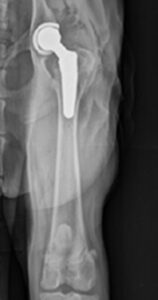-
Adopt
-
Veterinary Care
Services
Client Information
- What to Expect – Angell Boston
- Client Rights and Responsibilities
- Payments / Financial Assistance
- Pharmacy
- Client Policies
- Our Doctors
- Grief Support / Counseling
- Directions and Parking
- Helpful “How-to” Pet Care
Online Payments
Referrals
- Referral Forms/Contact
- Direct Connect
- Referring Veterinarian Portal
- Clinical Articles
- Partners in Care Newsletter
CE, Internships & Alumni Info
CE Seminar Schedule
Emergency: Boston
Emergency: Waltham
Poison Control Hotline
-
Programs & Resources
- Careers
-
Donate Now
 By Nick Trout, MA, VET MB, DACVS, ECVS
By Nick Trout, MA, VET MB, DACVS, ECVS
Angell Animal Medical Center
www.angell.org/surgery
Surgery@angell.org
617-541-5048
Twenty years ago, as a surgical resident, I remember performing at least one triple pelvic osteotomy (TPO) a week. These days I’ll be lucky to do one a year. What changed in the world of canine hip dysplasia? If TPO remains a viable treatment option in young dogs, why has it become so uncommon?
Perhaps the answer lies in our criteria for selection of cases and the advent of new technology. When TPO was more popular, candidates were typically six to twelve months of age with minimal to no secondary osteoarthritis and a positive Ortolani sign, relinquishing that satisfying “thunk” and sense of “capture” when the subluxated femoral head returned to a sufficiently deep acetabulum. We would cut the ileum, ischium and pubis, apply corrective plates providing 20, 30 and 40 degrees of rotation, and the dogs invariably did well. The problem lay with those dogs, the majority, that required these greater amounts of angular correction to achieve a stable coxo-femoral joint. Years later many of these cases would return, their hindleg function in decline and follow-up radiographs defining significant progression of hip arthritis. If medical management proved ineffective, fraught with side effects or unsatisfactory to the owner, total hip replacement (THR) might have been recommended. At this point many owners would say, “Why didn’t you just do a hip replacement in the first place?”
Back then we would hesitate to perform a cemented THR on dogs less than two years of age, but now, with non-cemented or biologic hip replacement systems, young dogs, (10-24 months) that might have been less than ideal candidates for a TPO can undergo a corrective hip surgery that aims to be the one and only procedure necessary.
Biomedtrix offers a modular press-fit non-cemented hip replacement system (BFX) that utilizes the instruments and components of their cemented system (CFX) thereby providing great versatility and the ability to use hybrid implants if needed. Orthoview software programs enable exceptional preoperative planning with digital radiographs to ensure appropriate implant sizing.
Dogs come into the hospital the morning of surgery, stay overnight and typically go home the following day. Most dogs will demonstrate partial weight bearing when they leave and good use of the leg (70-90%) by two weeks when they return for staple removal. I like to remove the staples myself so I can assess the incision, palpate the hip range of motion and ensure adequate exercise restriction at this early stage. Dogs may begin physical therapy at this time.
At ten weeks, dogs return for a final recheck to assess walk and trot, hindleg muscle mass, and follow-up radiographs to confirm implant stability.
Total hip replacement is not for everyone or every dysplastic dog. The vast majority of dogs with osteoarthritis of the hip can do well with a conservative approach (weight loss, exercise modification, joint supplements, NSAIDs, and/or physical therapy). But it’s nice to know that there is a great surgical option out there for those younger patients looking for a surgical fix.
If you have questions, contact Dr. Trout at surgery@angell.org or 617-541-5048.
